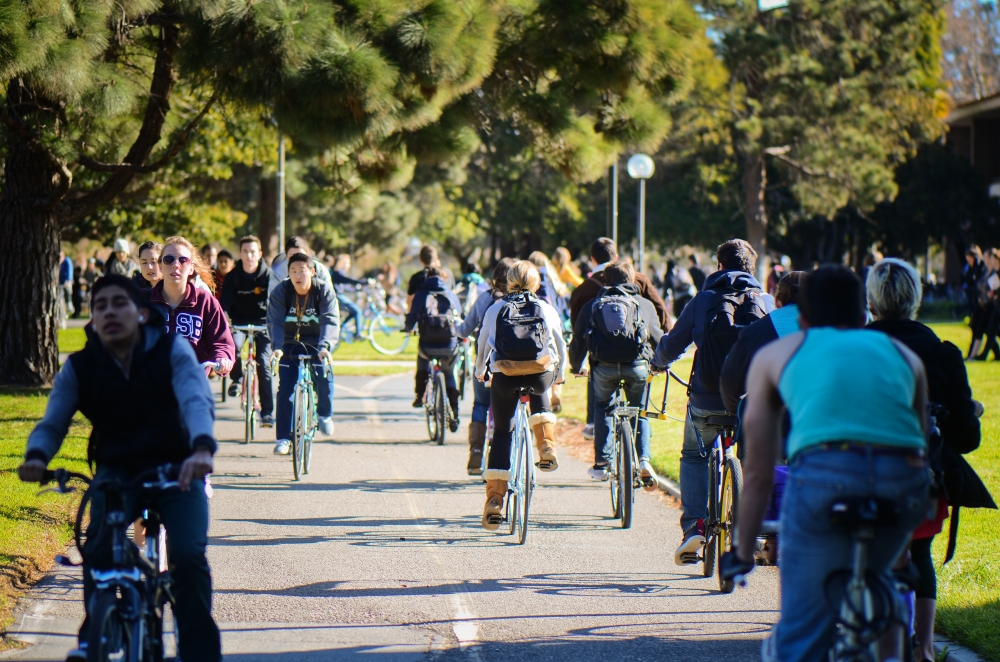
Play It Cool
By some accounts, the modern environmental movement was sparked in Santa Barbara or, at least, by the widespread outrage over the devastating 1969 oil spill that occurred off the coast here. For UC Santa Barbara, the disaster spurred not only formalization of an environmental studies program that is today among the best of its kind, but also a drive toward sustainability that has made it a leader in all things green.
UCSB hopes to channel that determination to best the competition in the UC-wide Cool Campus Challenge. Launching today, the 10-week online contest between the 10 UC campuses is designed to motivate and reward staff, faculty and students who take steps to reduce their carbon footprints and help the UC system reach carbon neutrality by 2025.
“Experiencing the 1969 oil spill right off the bluff of our campus really made an impact on UCSB and how we think about the environment — and we hired our first energy managers shortly thereafter,” said Mo Lovegreen, sustainability director at UCSB. “We have made great strides over the decades in improving energy efficiency, thereby reducing our environmental impact. In just the past 10 years, we have reduced electricity use per square foot by 39 percent and natural gas use by over 54 percent. Is this enough? Absolutely not.
“If we are to meet the president’s commitment of achieving climate neutrality by 2025, it will require participation of every faculty member, staff member and student,” Lovegreen added. “Each one of us can make a difference by changing how we behave within our campus settings. If you are in an office, it could include converting to using an LED task lamp rather than overhead lights, turning off equipment that is not in use, or simply wearing a sweater rather than using the heater. All these little things add up to big reductions. The Cool Campus Challenge is designed to help us think through some of our behaviors and make a commitment to improving.”
The Cool Campus Challenge is an important part of UC President Janet Napolitano’s 2013 Carbon Neutrality Initiative, which outlines the direct actions the university will take to address the growing crisis of climate change driven by fossil fuel emissions. A collaboration between the UC and the UC Berkeley Renewable and Appropriate Energy Laboratory, the challenge is the first major cross-campus effort to engage staff, faculty and students alike in a communal effort to become carbon neutral.
“UC campuses are already leading the world in so many ways. Now we’re on our way to becoming the very first university system to wipe out our carbon footprint for good,” said Napolitano. “It’s a daring goal, and one that we can only meet if we work together, which is why the challenge is so important.”
Each week of the challenge will highlight an important theme along with suggested actions that will directly reduce greenhouse gas emissions and increase education and awareness about climate disruption. These activities can be as simple as turning off lights, taking public transportation or eliminating space heaters.
In the spirit of competition, staff and faculty members and students will have an opportunity to score points for their respective campuses and departments each time they complete one of the activities. Campuses with the most points will be eligible for raffle prizes, and the one with the most points accrued by the end of the Challenge will earn the title of “Coolest UC Campus.”
“What’s so great about the Cool Campus Challenge is that it will not only help to educate participants about UC’s carbon neutrality goal, but also engage individuals in behavior changes that will reduce our emissions,” said Jewel Snavely, sustainability coordinator for UCSB. “The campus that prevents the most greenhouse gas emissions will be named the Coolest UC and will take home a trophy and bragging rights. Are you ready Gauchos? It’s time to win!”
To sign-up for the challenge, visit the Cool Campus Challenge website.



